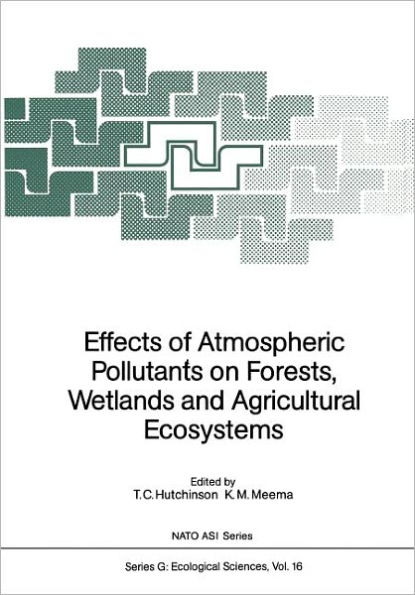5
1

Effects of Atmospheric Pollutants on Forests, Wetlands and Agricultural Ecosystems
652
by T.C. Hutchinson (Editor), K.M. Meema (Editor)
T.C. Hutchinson

Effects of Atmospheric Pollutants on Forests, Wetlands and Agricultural Ecosystems
652
by T.C. Hutchinson (Editor), K.M. Meema (Editor)
T.C. Hutchinson
Paperback(Softcover reprint of the original 1st ed. 1987)
$109.99
-
PICK UP IN STORECheck Availability at Nearby Stores
Available within 2 business hours
Related collections and offers
109.99
In Stock
Overview
T. C. Hutchinson The NATO Advanced Research Workshop detailed in this volume was held in Toronto, Canada, in 1985. The purpose of the Workshop was to provide a "state of the art" report on our knowledge of the sensitivities and responses of forests, wetlands and crops to airborne pollutants. Approximately 40 scientific experts from nine countries participated. Most participants were actively involved in research concerning the effects of air pollutants on natural or agro-ecosystems. These pollutants included acidic deposition, heavy metal particulates, sulphur dioxide, ozone, nitrogen oxides, acid fogs and mixtures of these. Also invited were experts on various types of ecosystem stresses, physiologi cal mechanisms pertinent to acid deposition, and other areas that were felt by the director to be of direct relevance, including: effects of ethylene on vegetation, the physiology of drought in trees, the nature and role of plant cuticles as barriers to acid rain penetration, the use of dendrochronological techniques in reconstructing the time of onset and the subsequent progression of growth declines, the ability of soils to naturally generate acidity, the role of Sphagnum moss in natural peat land acidity, the use of lichens as indicators of changing air quality, and the magnitude of natural emissions of reduced sulphur gases from tropical rainforests and temperate deciduous forests. The Workshop included a series of invited presentations and subsequent group discussions. These presentations were designed to allow syntheses of our present knowledge as well as detailed questioning and discussion.

Product Details
| ISBN-13: | 9783642708763 |
|---|---|
| Publisher: | Springer Berlin Heidelberg |
| Publication date: | 12/30/2011 |
| Series: | Nato ASI Subseries G: , #16 |
| Edition description: | Softcover reprint of the original 1st ed. 1987 |
| Pages: | 652 |
| Product dimensions: | 6.69(w) x 9.61(h) x 0.05(d) |
Table of Contents
Acknowledgements.- Participants of the Workshop.- Workshop Summary..- I: Geographical Overviews of Forest Decline.- Development and causes of novel forest decline in Germany.- Results of studies on forest decline in northwest Germany.- Forest damage in Switzerland, Austria, and adjacent parts of France and Italy in 1984.- Air pollution and forest damage in Norway.- Forest decline - the view from Britain.- Deterioration of red spruce in the northern appalachian mountains.- Sugar maple decline in Ontario.- 2: Responses of Plants to Acidic Deposition.- Deposition and forest canopy interactions of airborne nitrate.- Responses of herbaceous and woody plants to the dry deposition of SO2 and NO2.- Plant cuticle as a barrier to acid rain penetration.- The response of plant reproductive processes to acidic rain and other air pollutants.- Consequences of cloud water deposition on vegetation at high elevation.- Acid deposition, nurtrient imbalance and tree decline: a commentary.- III: Other Stresses Involved in Forest Decline.- Response of trees to drought.- Responses of American forests to phohemical oxidants.- Ozone toxicity - is there more than one mechanism of action?.- Ethylene: a possible factor in the response of plants to air pollution and acid precipitation.- Responses of forests in decline to experimental fertilization.- Decline as a phenomenon in forests: pathological and ecological considerations.- IV: Dendrochronological Studies.- The use and limitations of dendrochronology in studying effects of air pollution on forests.- Dendroecological analysis of acidic deposition effects on forest productivity.- Trace metal uptake and accumulation in trees as affected by environmental pollution.- V: Soil Acidification and Possible Toxicity.- Air pollution and soil acidification.- A discussion of the changes in soil acidity due to natural processes and acid deposition.- Soil acidification and metal solubility in forests of southern Sweden.- Differences in aluminum mobilization in spodosols in New Hampshire (USA) and in the Netherlands as a result of acid deposition.- Limits on cation leaching of weakly podzolized forest soils: an empirical evaluation.- Effects of heavy metals and aluminum on the root physiology of spruce (PiceaAbies Karst.) seedlings.- Aluminum toxicity in forest tree seedlings.- VI: Bryophyte and Lichen Studies.- The effect of simulated acid rain on boreal forest floor feather moss and lichen species.- Annual absorption of gaseous air pollutants by mosses and vascular plants in diverse habitats.- Effects of quantitative and qualitative changes in air pollution on the ecological and geographical performance of lichens.- VII: Agricultural Responses.- Crop responses to ozone–sulphur dioxide mixtures.- Stomate-dependent and stomate-independent uptake of NOX, and effects on photosynthesis, respiration and transpiration of potted plants.- The effects of acid rain, alone and in combination with gaseous pollutants, on growth and yield of crop plants.- VIII: Wetlands.- The natural and anthropogenic acidification of peatlands.- Interactions of Sphagnum with water and air.- Sources of alkalinity in Precambrian shield watersheds under natural conditions and after fire or acidification.- Responses to acidic deposition in ombrotrophic mires in the U.K..- The stratigraphic record of atmospheric loading of metals at the ombrotrophic Big Heath bog, Mt. Desert Island, Maine, U.S.A..- Proton cycling in bogs: geographic variation in northeastern north America.- IX: Ecosystems as a Source of Sulphur Emissions.- Potential sulphur gas emissionsfrom a tropical rainforest and a southern Appalachian deciduous forest.- X: Cause/Effect Relations for Plant Damage.- Perspectives on establishing the relationship between acidic deposition and vegetation responses.- XI: Meeting Summaries - Group Reports.- Forest Decline.- Forest Soils.- Perspectives of Air Pollution Effects on Crop Plants.- Wetlands.- Author Index.- Species Index.From the B&N Reads Blog
Page 1 of
